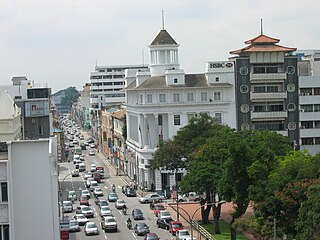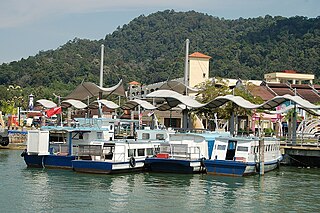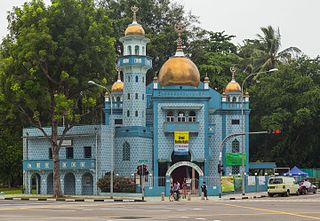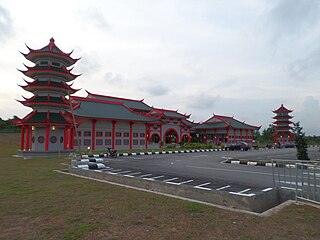
Perak is a state of Malaysia on the west coast of the Malay Peninsula. Perak has land borders with the Malaysian states of Kedah to the north, Penang to the northwest, Kelantan and Pahang to the east, and Selangor to the south. Thailand's Yala and Narathiwat provinces both lie to the northeast. Perak's capital city, Ipoh, was known historically for its tin-mining activities until the price of the metal dropped, severely affecting the state's economy. The royal capital remains Kuala Kangsar, where the palace of the Sultan of Perak is located. As of 2018, the state's population was 2,500,000. Perak has diverse tropical rainforests and an equatorial climate. The state's mountain ranges belong to the Titiwangsa Range, which is part of the larger Tenasserim Range connecting Thailand, Myanmar and Malaysia. Perak's Mount Korbu is the highest point of the range.

Ipoh is the capital city of the Malaysian state of Perak. Located by the Kinta River, it is nearly 180 km (110 mi) north of Kuala Lumpur and 123 km (76 mi) southeast of George Town in neighbouring Penang. As of 2010, Ipoh had a population of 657,892, making it the fourth largest city in Malaysia by population.

Lumut is a coastal town and mukim in Manjung District, Perak, Malaysia, situated about 84 km (52 mi) from Ipoh, 12 km (7.5 mi) from the town of Sitiawan and it is the main gateway to Pangkor Island before established Marina Island Pangkor as second gateway. It is noted for seashell and coral handicrafts. This once little-known fishing town has since become the home base of the Royal Malaysian Navy and the site of the biggest naval shipbuilder in Malaysia, Boustead.

Batu Gajah is a municipality in Kinta District, Perak, Malaysia. It is the capital of Kinta District.

Masjid Malabar or Malabar Muslim Jama-Ath Mosque, also known as Golden Dome Mosque; is Singapore's only Malabar Muslim mosque. The mosque is located at the junction of Victoria Street and Jalan Sultan in the Kampong Glam district, in the Rochor Planning Area within the Central Area. The mosque is built on the Sultan Mosque style with traditional blue and white lapis lazuli tile facade. The mosque was nicknamed as little cousin of the Sultan Mosque, because of similar golden domes.

Sultan Sulaiman Royal Mosque is Selangor's royal mosque, which is located in Klang, Selangor, Malaysia. It was constructed by the British in the early 1932 and was officially opened in 1933 by the late Almarhum Sultan Sir Alaeddin Sulaiman Shah.

The Sultan Salahuddin Abdul Aziz Shah Mosque is the state mosque of Selangor, Malaysia. It is located in Shah Alam. It is the country's largest mosque and also the second largest mosque in Southeast Asia by capacity. Its most distinguishing feature is its large blue and silver dome. The mosque has four minarets, one erected at each of the corners.

The Ubudiah Mosque is a small mosque located in the royal town of Kuala Kangsar, Perak, Malaysia.

The Sultan Idris Shah II Mosque is the state mosque of Perak, Malaysia. It is situated in Ipoh, Perak's capital city, near the Birch Memorial.

Kampung Laut Mosque is one of the oldest mosques in Malaysia. There is no confirmatory evidence when the building of the mosque took place. It is estimated to have been built sometime in the 15th century or 18th century. It is located on Jalan Kuala Krai, in Nilam Puri, Tumpat District, Kelantan.

Sultan Azlan Shah Airport is an airport that serves Ipoh, a city in the state of Perak, Malaysia. It is located 6 kilometres (3.7 mi) away from the city centre. Sultan Azlan Shah Airport has been ranked as the seventh busiest airport in Malaysia.
Leong Sin Nam 梁燊南, alias Leong Sin, Leung Sin, Leong Sin Hee, was a Malaysian businessman. He migrated and settled in British Malaya in 1898. From humble beginnings, he worked hard to become a wealthy tin mine owner in Perak. He was a businessman, an active community leader and a philanthropist. He was a Chinese revolutionary with similar aspirations as Dr. Sun Yat Sen and a strong supporter of the Chinese war efforts during the Sino-Japanese war.

Arthur Benison Hubback was an English architect and soldier who designed several important buildings in British Malaya, in both Indo-Saracenic architecture and European "Wrenaissance" styles. Major works credited to him include Kuala Lumpur railway station, Ubudiah Mosque, Jamek Mosque, National Textile Museum, Panggung Bandaraya DBKL, Ipoh railway station, and Kowloon railway station.
Dato' Y. T. Lee, also Lee Yoon Thim was a Malaysian Chinese architect active in Kuala Lumpur in the 1950s and 1960s. He helped "Build Merdeka" after Malaysian Independence, 1963. He moved in elite circles, and held several positions in the national government and in the Chinese community. He was a close friend to Prime Minister Tuanku Abdul Rahman and other political figures. He designed several of Kuala Lumpur's landmark buildings, such as: Chin Woo Stadium, UMNO building, Dewan Bahasa dan Pustaka, Federal Hotel, Kampung Baru Mosque, Ar-Rahman Mosque and the Masjid Al-Ubudiyah. In addition to his famous mosques in Kuala Lumpur, he also worked on middle eastern and Islamic architecture project, for example, Masjid Al- Ubudiyah in Kerling, Hulu Selangor which is opened in 1960. When this masjid is built, there was no electricity supply yet. Somehow now it has been used as a teaching place by the locals. His less well known works include the Too House, an addition for the Methodist Boys School, and healthcare-related and commercial work. In the early 1960s, a series of honours came his way: in 1960, he was granted the appellation of P.J.K.; in 1961, he was honoured as Justice of Peace and J.M.N in 1962; he was honoured as Dato' in 1964, an honorific similar to the British "Sir".

Malacca Chinese Mosque is a Chinese-style mosque in Krubong, Central Melaka District, Malacca, Malaysia. It is the third such mosque in Malaysia after the ones in Kelantan and Perak and was developed by the Malacca Chinese Muslim Association (Pertim). Its construction budget was approved by Deputy Prime Minister Muhyiddin Yassin in October 2011, while its construction was started in August 2012 by Warisan Harmoni Construction Sdn. Bhd. and completed in April 2014. The construction of the mosque cost 7.5 million Malaysian ringgits, with RM 5.9 million provided by the federal government and the remaining by Pertim and the public.

The Geological Museum is a museum in Ipoh, Kinta District, Perak, Malaysia.
This article lists important figures and events in the public affairs of British Malaya during the year 1940, together with births and deaths of prominent Malayans.

Jamek Mosque, officially Sultan Abdul Samad Jamek Mosque is one of the oldest mosques in Kuala Lumpur, Malaysia. It is located at the confluence of the Klang and Gombak River and may be accessed via Jalan Tun Perak. The mosque was designed by Arthur Benison Hubback, and built in 1909.




















